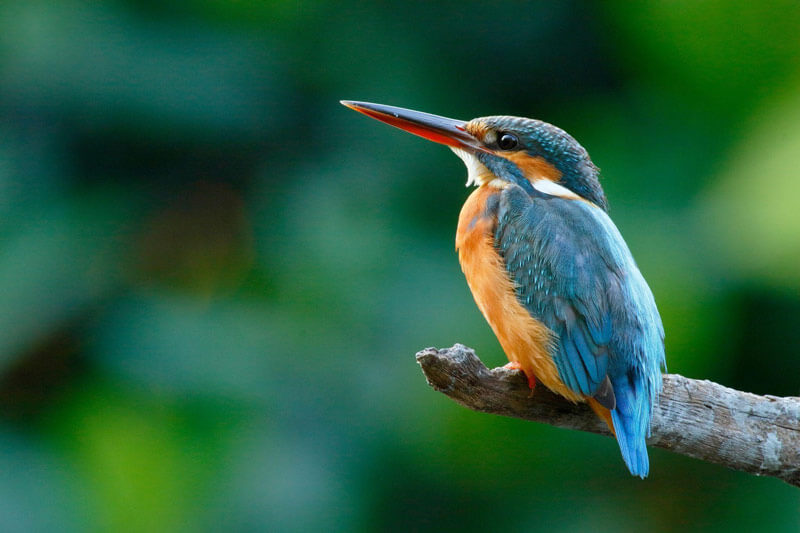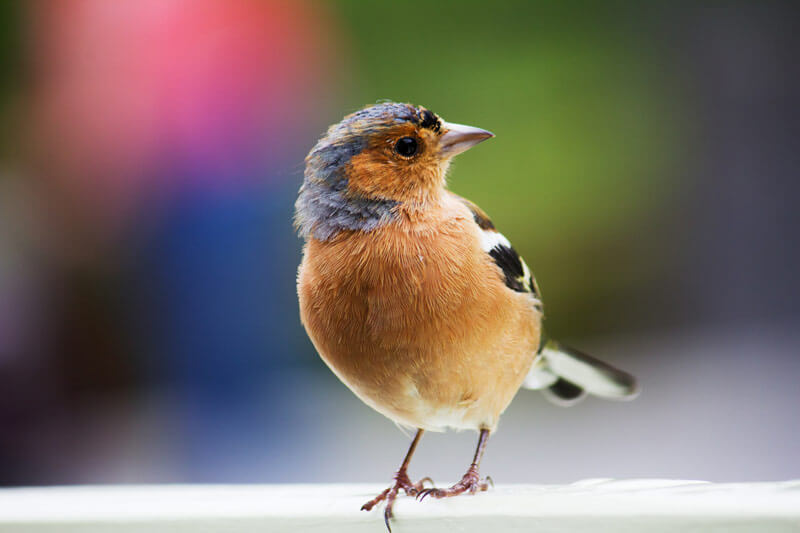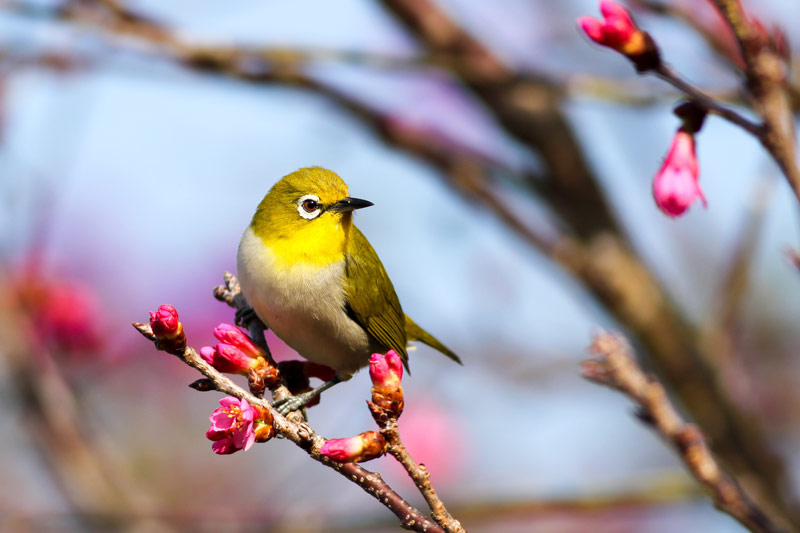A soft ray of sunlight slips through the window of your Smoky Mountain cabin and slips its way across your face. The chirp of morning birdsong floats through your window and wakes you slowly from a deep sleep. You lie there peacefully, taking it all in, grateful that you don’t have anything on the schedule – just the freedom of the great outdoors. Why not spend your day birdwatching?!
Birdwatching – or “birding” as enthusiasts call it is an enchanting way to immerse yourself in nature and check out the local North Carolina birds in their natural habitat. With so many protected natural forests, parks, and high-quality environments, North Carolina is a birdwatcher’s paradise. Whether you’re playing I spy with the naked eye, or you’re using binoculars and telescopes, check out our list of stunning settings that are perfect for birdwatching in the Smoky Mountains.
What Makes Birdwatching in the WNC Smoky Mountains Unique?
The Great Smoky Mountains are a bucket list destination for birdwatchers, and in Western North Carolina, we have unique habitats that make it an ideal place for birding. For example, in the Blue Ridge Mountains, you reach elevations of almost 7,000 feet, which draws birds of the Canadian eco-zone. This means you won’t find these birds anywhere else in the South!
From these towering peaks to the sheltered valleys below, you’ll find a diverse selection of nesting grounds and habitats that are home to some of the most varied birds in the world. With over 200 species, including migrating birds headed south for the winter or going home in the spring, there are year-round opportunities to spot some breathtaking birds and lose yourself in the magic of their songs.
Where to Go Birdwatching in the Smoky Mountains
With the dense, tall forests in the Smokies, you’re much more likely to hear more birds than you see. But even if you aren’t a birdsong expert, just follow the tweets and chirps, and you can find these amazing fine-feathered creatures. Here are some of the top spots in the Western North Carolina Smoky Mountains that birdwatchers love.
North Carolina Arboretum
The North Carolina Arboretum is a favorite spot for everyone who visits the WNC area. A 434-acre public garden located in the Bent Creek Experimental Forest of the Pisgah National Forest, this stunning place is a center for education, research and conservation. When you arrive, be sure to swing by the Baker Exhibit to pick up your Trail and Gardens Map and a bird list. The best spots for birdwatching are the Stream Garden, Nature Garden Trail, and National Native Azalea Repository.
Birds to Look For: Yellow-bellied Sapsucker, Blue-headed Vireo, Black-throated Green Warbler, American Redstart, and more.
Hike to Chimney Rock
Get out of your car and hit the hiking trails to fully immerse yourself in the birdwatching experience. Stretch your legs and lungs as you explore this 1,000-acre park in the heart of Hickory Nut Gorge. There are four hiking trails that range in difficulty from easy to moderate, plus you’ll get a breathtaking glimpse of a 404-foot waterfall. From the low-lying riverbanks to the towering monolith that is Chimney Rock, a wide variety of birds call this area home. (P.S. This is the perfect family-friendly spot to introduce kids to birdwatching. Check out their Birds of Prey program for a real thrill!)
Birds to Look For: Peregrine Falcon, Broad-winged Hawks, Sharp-shinned Hawks, Cooper’s Hawks, Red-shouldered Hawks, Yellow and Yellow-throated Warbler, Belted Kingfisher, Scarlet Tanager
Clingmans Dome
Clingmans Dome is one of the most popular birdwatching spots in Great Smoky Mountains National Park. As the tallest point in Tennessee, Clingmans Dome is home to birds who live in higher elevations. The habitat around the Dome is similar to northern boreal forests, so listen out for the trills of the chickadee and the song of the Canada warbler. From the viewing tower, you’ll get breathtaking panoramic views that are well above the treeline, giving you a unique opportunity for catching a glimpse of birds like the red-breasted nuthatch, northern saw-whet owl, dark-eyed junco, wood thrush, and more.
Beaver Lake Bird Sanctuary
This 10-acre bird sanctuary on the north side of Asheville is an oak forest with mixed hardwoods and pine, plus an early successional, bog/wetland and lake. All this together creates an incredible habitat for waterfowl and migratory species in the spring and fall. They have a convenient and accessible boardwalk loop that makes it easy to navigate your way through the gorgeous natural setting without disturbing the wildlife you came to see.
Birds to Look For: Yellow Warbler, Gray Catbird, Blue‐gray Gnatcatcher, Great Blue Heron, Green Heron, Brown‐headed Nuthatches, Chimney Swift, Baltimore and Orchard Orioles, Eastern Kingbird, Warbling Vireo
Blue Ridge Parkway
Winding its way for a whopping 469 miles through the aptly named Blue Ridge Mountains, the Parkway boasts jaw-dropping scenic mountain views, hiking trails, and over 250 bird species. Bull Creek is an Audubon Important Bird Area (IBA) along the Parkway and is a birdwatcher’s favorite. During peak tourist times, the traffic and noise can pick up during the day, so get there early for a peaceful birding experience. (Hop on the Parkway from Asheville, or head west to the Balsam Range near Waynesville for bonus birding spots.)
Birds to Look For: Red-breasted Nuthatch, Black-throated Green Warbler, Golden-crowned Kinglet and Canada Warbler, Northern Saw-whet Owls, American Kestrels, Great Blue Herons, Wood Ducks, Kingfishers, Sandpipers, Bitterns, Great Egrets, Cerulean Warblers, Peregrine Falcons, Appalachian Yellow-bellied Sapsucker
Gear up for Birdwatching in the Smokies
One of the great things about birdwatching as a hobby is that you don’t need a ton of gear. All you really need are binoculars and maybe a way to document your sightings. The forests in Great Smoky Mountains National Park are thick and lush, so you may have trouble getting a good view of some of the birds. A pair of binoculars will help you see through the trees while still safely protecting the local flora and fauna on your wooded hikes.
The Birds of the Smoky Mountains Checklist is a great guide to use along the way. There are also plenty of apps available to help you look up different species before, during, or after your birdwatching adventure. Some apps even include the specific birdsongs and calls. Learning their signature sounds can help you track them.
Birdwatching in the Smoky Mountains is an incredible way to experience nature, but it’s also an excellent learning opportunity for adventurers of all ages. Get outdoors and explore the Western North Carolina Smoky Mountains in a new and exciting way! And once you’re done exploring, book a room with us at the Meadowlark Motel for a good night’s rest.











